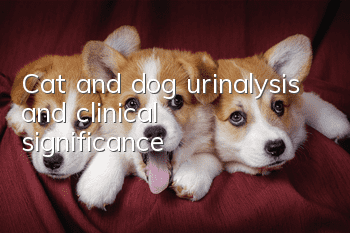Cat and dog urinalysis and clinical significance

1. General character inspection
1. Urine output
Several situations of abnormal urine output in dogs: 20-40ml/kg/day, in cats: 22-30ml/kg/day: 1. Polyuria is more common in the following diseases (1) Endocrine diseases: such as diabetes, primary parathyroid function Hyperactivity and primary aldosteronism, etc. (2) Kidney diseases: such as chronic pyelonephritis, hypertensive nephropathy, chronic renal tubular failure, etc. (3) Psychogenic polyuria: mostly caused by mental factors, such as tension, excessive work pressure, etc. 2. Oliguria or anuria is common in the following diseases (1) Kidney diseases: such as acute glomerulonephritis, acute attack of chronic nephritis, acute renal failure, etc. (2) Shock, severe dehydration or electrolyte imbalance caused by various reasons, or urinary tract obstruction caused by various reasons.
2. Color
Normal fresh urine in dogs is light yellow and in cats it is yellow and transparent liquid. After being left for a period of time, trace amounts of flocculent precipitates can be seen. The color of urine is often related to food, drugs and urine output. Common types of abnormally colored urine include the following - 1. Red. When the urine contains a certain amount of red blood cells, the urine turns red, which is medically called hematuria. Commonly seen in renal tuberculosis, renal tumors, kidney or urinary tract stones, acute glomerulonephritis, pyelonephritis, cystitis, etc. It can also be seen in bleeding disorders, such as thrombocytopenic purpura, hemophilia, etc. Note: Taking dyes, drugs, etc. can also cause red urine, so careful identification is required. 2. Soy sauce or strong brown color is common in favismosis, black urine fever, acute hepatitis, paroxysmal nocturnal hemoglobinuria and blood transfusion reactions with incompatible blood types. 3. Milky white: common in filariasis, tuberculosis, tumors, chest and abdominal trauma, or obstruction of lymphatic circulation around the kidneys due to certain reasons. In addition, when patients suffer from urinary system infections, such as cystitis, pyelonephritis, etc., white cloudy precipitates can be seen after urine is placed. Note: Normal urine may also appear milky white if it contains a large amount of phosphate, especially in winter when the temperature is low. 4. Yellow color is common in obstructive jaundice and hepatocellular jaundice. This is caused by the large amount of conjugated bilirubin in the urine. It can also be seen after taking certain drugs, such as riboflavin, berberine, metronidazole, etc. 5. Blue-green color is more common after using methylene blue, indomethacin, triamterene and other drugs.
3. Smell
After normal urine is left for a long time, an ammonia odor may appear due to the decomposition of urea. If the urine smells of ammonia when discharged, this may indicate chronic cystitis or chronic urinary retention. If the urine has an apple-like smell, it is more common in patients with diabetic ketoacidosis. In addition, eating certainSome foods, such as garlic and onions, can also cause urine to have a special smell.
2. Routine urine examination
1. Urobilinogen
Normal reference value: positive
The amount of urobilinogen in urine is only trace under physiological conditions. It increases slightly when hungry, after meals, exercise, etc. However, if the urine is diluted more than 4 times and is still positive, it indicates an increase in urobilinogen, which is a pathological indication.
Increased urobilinogen in urine is common in the following diseases - Impaired liver function, such as liver disease, heart failure, etc.
People with excessive bilirubin production in the body and unobstructed bile ducts are more common in patients with internal bleeding or various hemolytic diseases.
Increased urobilinogen reabsorption from the intestine is more common in patients with refractory constipation and intestinal obstruction.
Negative, seen in obstructive jaundice.
2. Urinary bilirubin
Normal reference value:
Negative(-)
Clinical significance: Urinary bilirubin examination is an important examination to show liver cell damage and identify jaundice. Positive: Found in obstructive jaundice caused by cholelithiasis, biliary tract tumors, biliary roundworms, and pancreatic head cancer, and hepatocellular jaundice caused by liver cancer, cirrhosis, acute and chronic hepatitis, and hepatocellular necrosis. Negative: negative reaction in hemolytic jaundice. When hepatic and obstructive jaundice are combined with severe renal damage, urinary bilirubin will be negative.
3. Ketone bodies
Normal reference value: Negative (-) Clinical significance: Positive, seen in diabetes, acidosis, vomiting of pregnancy, eclampsia, diarrhea, poisoning, typhoid fever, measles, scarlet fever, pneumonia, sepsis, acute rheumatic fever, acute miliary tuberculosis, and convulsions wait. In addition, hunger, excessive fat and protein intake after childbirth, etc. can also appear positive.
4. Occult blood
Normal reference value: negative
5.Protein
Normal reference value: negative
Positive clinical significance: seen in various acute and chronic glomerulonephritis, acute pyelonephritis, multiple myeloma, renal transplantation, nephrotic syndrome caused by various reasons, etc.;
Urinary system infection: such as pyelonephritis, cystitis or renal tuberculosis;
Other diseases: such as cardiac insufficiency, hypertensive nephropathy, diabetic nephropathy, hyperthyroidism, systemic lupus erythematosus, sepsis, leukemia, etc.
In addition, damage to renal tubular epithelial cells caused by drug, mercury, drug poisoning, etc. can also be positive.
6. Nitrate
Normal reference value: negative
Clinical significance: Positive, seen in urinary system infections such as cystitis and pyelonephritis.
7. White blood cells Normal reference value: negative
Clinical significance: increased: seen in acute glomerulonephritis, pyelonephritis, cystitis, urethritis, urethral tuberculosis, etc.
8. Glucose Normal reference value: negative
Clinical significance: Positive, found in diabetes, hyperthyroidism, anterior pituitary hyperfunction, phaeocytoma, pancreatitis, pancreatic cancer, severe renal insufficiency, etc. In addition, stress-induced diabetes may also occur due to craniocerebral trauma, cerebrovascular accident, concussion, acute myocardial infarction, etc. Excessive intake of high-sugar foods can also cause a transient increase in blood sugar, causing urine glucose to be positive.
9. Proportion
The urine specific gravity of infants and young children is low, and the urine specific gravity is affected by age, water intake and sweating. The level of urine specific gravity mainly depends on the concentration function of the kidneys, so measuring urine specific gravity can be used as one of the kidney function tests. Normal reference values: dogs 1.015-1.045, cats 1.015-1.060 Clinical significance:
Decreased urine specific gravity: Common in chronic pyelonephritis, diabetes insipidus, chronic glomerulonephritis, polyuria stage of acute renal failure, etc.
Increased urine specific gravity: More common in diabetes, high fever, vomiting, diarrhea, dehydration, shock, acute glomerulonephritis, and heart failure.
10.PH
Normal reference value: The pH value (acidity and alkalinity) of dog and cat urine is between 5.0-7.0, usually around 6.0. Normal urine is weakly acidic, or it can be neutral or weakly alkaline. The pH of urine depends to a large extent on the type of diet, medications taken and the type of disease. Clinical significance: Urine pH value is lower than the normal value: common in acidosis, diabetes, gout, leukemia, or taking acidic drugs (such as ammonium chloride); Urine pH value is higher than the normal value: common in alkalosis, cystitis, or taking sodium bicarbonate Alkaline drugs, etc.
11. Vitamin C
Normal reference value: negative
Clinical significance: Vitamin C is affected by food. If the food contains high vitamin C content, the urine may be higher than the normal value. This is normal. Vitamin C is an antioxidant, similar to that found in chemical reactions"reducing agent". Therefore, as long as there is an "oxidation-reduction reaction" process in any laboratory examination, vitamin C may be involved, thereby affecting the test results. The most common one is the impact on urinalysis - a large intake of vitamin C can cause false negative results in laboratory tests such as urinary occult blood, urine sugar, urinary ketones and nitrite (it was originally a problem, but was not checked out), which may cause doctors to misjudge the disease. Therefore, urine routine vitamin C+3 will not directly have a great impact on the body.
Urine indicators can be roughly divided into four categories: kidney disease, diabetes, urinary infection and other diseases.
1. Kidney disease indicators: pH, specific gravity (SG), occult blood or red blood cells (BLD, ERY), protein (PRO) and color (COL). The normal reference values are: 4.6~8.0, 1.005~1.030, positive, negative, light yellow to deep yellow. Changes in these indicators may indicate renal damage.
2. Diabetes indicators: pH, protein, specific gravity, sugar (GLU) and ketone bodies (KET). The detection of these indicators can help diagnose related complications and whether some organs of the body are damaged, such as whether ketonemia occurs. Under normal circumstances, urine glucose and ketone bodies are negative.
3. Urinary infection indicators: white blood cells (WBC), occult blood or red blood cells, nitrite (NIT), color and turbidity (TUR). When the urinary system is infected by bacteria, white blood cells and red blood cells often appear in the urine, the color or turbidity of the urine also changes, and nitrite is sometimes positive. Chemical detection of urinary white blood cells and occult blood or red blood cells only plays a screening role, and clinical diagnosis is based on the results of microscopic examination.
4. Other disease indicators, mainly pH, specific gravity, bilirubin (BIL), urobilinogen (URO), color and other indicators. The two indicators of bilirubin and urobilinogen reflect the ability and amount of heme metabolism in the liver. Under normal circumstances, urinary bilirubin is negative and urobilinogen is weakly positive. When the above indicators increase, it often indicates jaundice and the urine color turns yellow-green.
Tip: If "1+" or "3+"...or +, +++ appears after some items on the urine routine analysis test sheet, the superficial test result is positive; on the contrary, if it is "-", it means the test result is negative. . When reading the report, you must analyze the report objectively, because there are many interfering factors that affect the accuracy of the test results, such as dietary factors, some interfering substances in urine, etc. When abnormalities appear in routine urine tests, please do not be too nervous or worried; similarly, when test results inconsistent with clinical manifestations appear, do not be blindly optimistic. Be sure to cooperate with the clinicianFurther examination and analysis are done to avoid delaying the diagnosis of the disease.
- How long do dogs live, and how long can we stay with them?
- What should I do if my puppy has canine distemper?
- Beginners must know: several taboos for novice dog owners!
- Can dogs eat chicken legs?
- Why does border collie nose peel?
- Will a dog heal faster if he licks his wound?
- Dog dies after making sound of water in belly
- Dog’s behavior 10 days before giving birth
- Why can't dogs enter the cemetery?
- Portal vein short circuit in dogs



